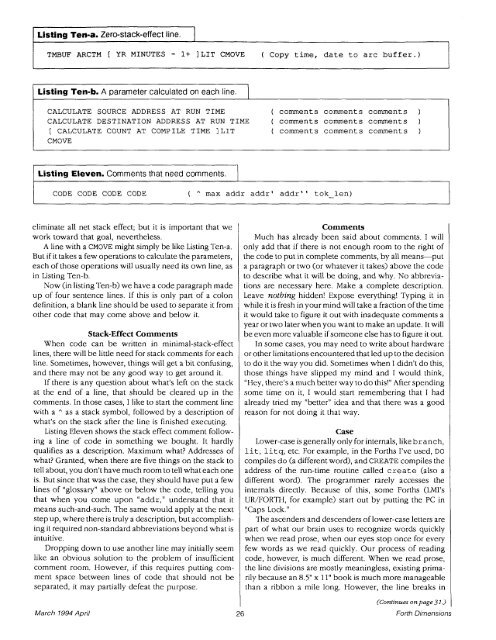FAST Forth Native-Language Embedded Computers
FAST Forth Native-Language Embedded Computers
FAST Forth Native-Language Embedded Computers
You also want an ePaper? Increase the reach of your titles
YUMPU automatically turns print PDFs into web optimized ePapers that Google loves.
Listing Ten-a. Zero-stack-effect line.<br />
TMBUF ARCTM [ YR MINUTES - I+ ]LIT CMOVE ( Copy time, date to arc buffer.)<br />
Listing Ten-b. A parameter calculated on each line.<br />
CALCULATE SOURCE ADDRESS AT RUN TIME ( comments comments comments )<br />
CALCULATE DESTINATION ADDRESS AT RUN TIME ( comments comments comments )<br />
[ CALCULATE COUNT AT COMPILE TIME ]LIT ( comments comments comments )<br />
CMOVE<br />
Listing Eleven. Comments that need comments.<br />
CODE CODE CODE CODE ( A max addr addr' addr" tok-len)<br />
eliminate all net stack effect; but it is important that we<br />
work toward that goal, nevertheless.<br />
A line with a CMOVE might simply be like Listing Ten-a.<br />
But if it takes a few operations to calculate the parameters,<br />
each of those operations will usually need its own line, as<br />
in Listing Ten-b.<br />
Now (in listing Ten-b) we have a code paragraph made<br />
up of four sentence lines. If this is only part of a colon<br />
definition, a blank line should be used to separate it from<br />
other code that may come above and below it.<br />
Stack-Effect Comments<br />
When code can be written in minimal-stack-effect<br />
lines, there will be little need for stack comments for each<br />
line. Sometimes, however, things will get a bit confusing,<br />
and there may not be any good way to get around it.<br />
If there is any question about what's left on the stack<br />
at the end of a line, that should be cleared up in the<br />
comments. In those cases, I like to start the comment line<br />
with a A as a stack symbol, followed by a description of<br />
what's on the stack after the line is finished executing.<br />
Listing Eleven shows the stack effect comment follow-<br />
ing a line of code in something we bought. It hardly<br />
qualifies as a description. Maximum what? Addresses of<br />
what? Granted, when there are five things on the stack to<br />
tell about, you don't have much room to tell what each one<br />
is. But since that was the case, they should have put a few<br />
lines of "glossary" above or below the code, telling you<br />
that when you come upon "addr," understand that it<br />
means such-and-such. The same would apply at the next<br />
step up, where there is truly a description, but accomplish-<br />
ing it required non-standard abbreviations beyond what is<br />
intuitive.<br />
Dropping down to use another line may initially seem<br />
like an obvious solution to the problem of insufficient<br />
comment room. However, if this requires putting com-<br />
ment space between lines of code that should not be<br />
separated, it may partially defeat the purpose.<br />
Comments<br />
Much has already been said about comments. I will<br />
only add that if there is not enough room to the right of<br />
the code to put in complete comments, by all means-put<br />
a paragraph or two (or whatever it takes) above the code<br />
to describe what it will be doing, and why. No abbrevia-<br />
tions are necessary here. Make a complete description.<br />
Leave nothing hidden! Expose everything! Typing it in<br />
while it is fresh in your mind will take a fraction of the time<br />
it would take to figure it out with inadequate comments a<br />
year or two later when you want to make an update. It will<br />
be even more valuable if someone else has to figure it out.<br />
In some cases, you may need to write about hardware<br />
or other limitations encountered that led up to the decision<br />
to do it the way you did. Sometimes when I didn't do this,<br />
those things have slipped my mind and I would think,<br />
"Hey, there's a much better way to do this!" After spending<br />
some time on it, I would start remembering that I had<br />
already tried my "better" idea and that there was a good<br />
reason for not doing it that way.<br />
Case<br />
Lower-case is generally only for internals, like branch,<br />
lit, litq, etc. For example, in the <strong>Forth</strong>s I've used, DO<br />
compiles do (a different word), and CREATE compiles the<br />
address of the run-time routine called create (also a<br />
different word). The programmer rarely accesses the<br />
internals directly. Because of this, some <strong>Forth</strong>s (LMl's<br />
UR/FORTH, for example) start out by putting the PC in<br />
"Caps Lock."<br />
The ascenders and descenders of lower-case letters are<br />
part of what our brain uses to recognize words quickly<br />
when we read prose, when our eyes stop once for every<br />
few words as we read quickly. Our process of reading<br />
code, however, is much different. When we read prose,<br />
the line divisions are mostly meaningless, existing prima-<br />
rily because an 8.5" x 11" book is much more manageable<br />
than a ribbon a mile long. However, the line breaks in<br />
(Continues onpage 31 .)<br />
March 1994 Aprjl 26 <strong>Forth</strong> Dimensions
















